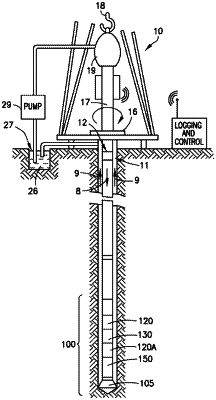| CPC G01V 1/50 (2013.01) [G01V 2200/16 (2013.01); G01V 2210/42 (2013.01); G01V 2210/47 (2013.01); G01V 2210/6222 (2013.01)] | 11 Claims |

|
1. A method of characterizing properties of structures of interest in a formation traversed by a borehole, comprising:
operating a sonic logging tool in the borehole to transmit acoustic signals that probe nearby formation structures and to receive acoustic signals that result from interaction with the nearby formation structures;
generating waveform data associated with the received acoustic signals as a function of measured depth in the borehole;
acquiring and/or processing the waveform data to identify or label clusters of Slowness-Time-Coherence peaks;
tracking at least one cluster of Slowness-Time-Coherence peaks over varying depth values;
performing a coherence optimization process on the at least one cluster of Slowness-Time-Coherence peaks to produce data;
generating a log of an acoustic property of the formation as a function of depth based on the data produced by the coherence optimization process;
using an optimization process to determine the acoustic property; and
applying a tracking algorithm to cluster vertices of different resolution Slowness-Time-Coherence peaks,
wherein the optimization process is a multi-resolution based coherence optimization process which includes grouping the different resolution Slowness-Time-Coherence peaks, and
wherein a machine-learning based algorithm is used to perform the grouping of the different resolution Slowness-Time-Coherence peaks.
|